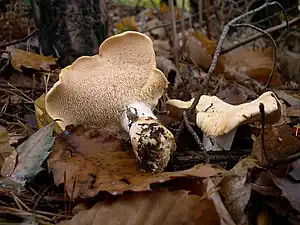Hydnum
Hydnum is a genus of fungi in the family Hydnaceae. They are notable for their unusual spore-bearing structures of teeth rather than gills. The best known are the edible species Hydnum repandum and H. rufescens. There are no known toxic varieties of Hydnum.[2] Widely regarded as important maintainers of forest ecosystems, the Hydnum genus is known to have ectomycorrhizal relationships with multiple plant families.[3] Hydnum has many brittle, white teeth from which the spores drop. Some species have teeth which hang from ascending branches, while other species have teeth which project downwards from the undersurfaces of dead wood. Most Hydnum species are safe to eat, and contain many fatty acids and antioxidants.[4]
| Hydnum | |
|---|---|
 | |
| Hydnum repandum | |
| Scientific classification | |
| Domain: | Eukaryota |
| Kingdom: | Fungi |
| Division: | Basidiomycota |
| Class: | Agaricomycetes |
| Order: | Cantharellales |
| Family: | Hydnaceae |
| Genus: | Hydnum L. (1753) |
| Type species | |
| Hydnum repandum L. (1753) | |
| Synonyms[1] | |
|
Erinaceus Dill. (1719) | |
Taxonomy and diversity
Hydnum species are found on every continent that is habitable for plant life, with some preferring deep forest regions.[5] Most of the common species, such as H. repandum and H. rufescens can be located in Europe, East Asia, and Australia.[6]
Hydnum repandum is a common and edible species. Also called the "hedgehog mushroom", H. repandum is most often found in Europe, Mexico, and North America.[3] The smooth cap grows as wide as 8 inches across, and the stem is off-center and is less than 2 inches long. H. repandum is often confused in looks for its similar tasting cousin, the Chantrelle mushroom.[7] Medicinally, H. repandum has shown promising signs in preventing malignant sarcomas in mice.[8]
Hydnum rufescens is another common edible variety of hydnum. Known locally as the terracotta hedgehog mushroom, it can be found in Portugal.[9] It has been found to contain high levels of fatty acids and nutrients essential to the human diet.[9]
Hydnum minum is a new species that was described in 2015. First located in Japan, H. minum is identifiable by a "whitish basidiomata", or spore-producing structure.[6]
Hydnum vesterholtii has been newly found in calcium rich areas of the Mediterranean, as well as in the Pyrenees and Italy, and is recognized by an ochre tinted spore cap.[10]
Hydnum ovoideisporum, much like H. vesterholtii, has an orangish colored cap. It is also found in the Iberian-Mediterranean climate and is fond of calcium rich soils.[11]
Species
- Hydnum albomagnum
- Hydnum crocidens
- Hydnum dispersum
- Hydnum durieui
- Hydnum elatum
- Hydnum ellipsosporum
- Hydnum investiens
- Hydnum magnorufescens
- Hydnum minum
- Hydnum molluscum
- Hydnum oregonense
- Hydnum ovoideisporum
- Hydnum papyraceum
- Hydnum repandum
- Hydnum rufescens
- Hydnum umbilicatum
- Hydnum vesterholtii
References
- "Hydnum L. 1753". MycoBank. International Mycological Association. Retrieved 2011-06-17.
- Cao, Ting; Hu, Ya-Ping; Yu, Jia-Rui; Wei, Tie-Zheng; Yuan, Hai-Sheng (2021-06-01). "A phylogenetic overview of the Hydnaceae (Cantharellales, Basidiomycota) with new taxa from China". Studies in Mycology. 99 (1): 100121. doi:10.1016/j.simyco.2021.100121. PMC 8717575. PMID 35035603.
- Feng, Bang; Wang, Xiang-Hua; Ratkowsky, David; Gates, Genevieve; Lee, Su See; Grebenc, Tine; Yang, Zhu L. (May 2016). "Multilocus phylogenetic analyses reveal unexpected abundant diversity and significant disjunct distribution pattern of the Hedgehog Mushrooms (Hydnum L.)". Scientific Reports. 6 (1): 25586. doi:10.1038/srep25586. ISSN 2045-2322. PMC 4858670. PMID 27151256.
- Sułkowska-Ziaja, Katarzyna; Muszyńska, Bożena; Szewczyk, Agnieszka (April 2015). "Antioxidant components of selected indigenous edible mushrooms of the obsolete order Aphyllophorales". Revista Iberoamericana de Micología. 32 (2): 99–102. doi:10.1016/j.riam.2013.10.011. PMID 24657542.
- Sugawara, Ryo; Sotome, Kozue; Maekawa, Nitaro; Nakagiri, Akira; Endo, Naoki (May 2021). "Mycorrhizal synthesis, morpho-anatomical characterization of mycorrhizae, and evaluation of mycorrhiza-forming ability of Hydnum albidum–like species using monokaryotic and dikaryotic cultures". Mycorrhiza. 31 (3): 349–359. doi:10.1007/s00572-021-01024-7. ISSN 0940-6360. PMID 33616720. S2CID 231990526.
- Sugawara, Ryo; Maekawa, Nitaro; Sotome, Kozue; Nakagiri, Akira; Endo, Naoki (2022-03-04). "Systematic revision of Hydnum species in Japan". Mycologia. 114 (2): 413–452. doi:10.1080/00275514.2021.2024407. ISSN 0027-5514. PMID 35394899. S2CID 248050053.
- Antonyuk, Volodymyr; Panchak, Lidiia V.; Antonyuk, Lidiia Ya; Zyn, Alina R. (2021-01-17). "Extractive Substances of Fruit Body Golden Chanterelle (Cantharellus Cibarius Fr.) and Hedgehog Mushroom (Hydnum Repandum Fr.)". Emirates Journal of Food and Agriculture: 826. doi:10.9755/ejfa.2020.v32.i11.2195. ISSN 2079-0538. S2CID 234177776.
- Peksen, A; Kibar, B; Yakupoglu, G (2013-10-14). "Favourable culture conditions for mycelial growth of Hydnum repandum, a medicinal mushroom". African Journal of Traditional, Complementary and Alternative Medicines. 10 (6): 431. doi:10.4314/ajtcam.v10i6.4. ISSN 0189-6016. PMC 3847377. PMID 24311862.
- Ribeiro, Bárbara; Guedes de Pinho, Paula; Andrade, Paula B.; Baptista, Paula; Valentão, Patrícia (2009-09-01). "Fatty acid composition of wild edible mushrooms species: A comparative study". Microchemical Journal. 93 (1): 29–35. doi:10.1016/j.microc.2009.04.005. hdl:10198/4409. ISSN 0026-265X.
- Vizzini, A; Picillo, B; Ercole, E; Voyron, S; Contu, M (2012). "Detecting the variability of Hydnum ovoideisporum (Agaricomycetes, Cantharellales) on the basis of Italian collections, and H. magnorufescens sp. nov" (PDF). Mycosphere. 4 (1): 32–44. doi:10.5943/mycosphere/4/1/2.
- Olariaga, Ibai; Grebenc, Tine; Salcedo, Isabel; Martín, María P. (2012-11-01). "Two new species of Hydnum with ovoid basidiospores: H. ovoideisporum and H. vesterholtii". Mycologia. 104 (6): 1443–1455. doi:10.3852/11-378. ISSN 0027-5514. S2CID 44252712.